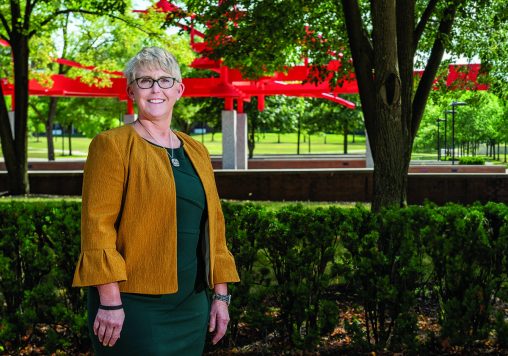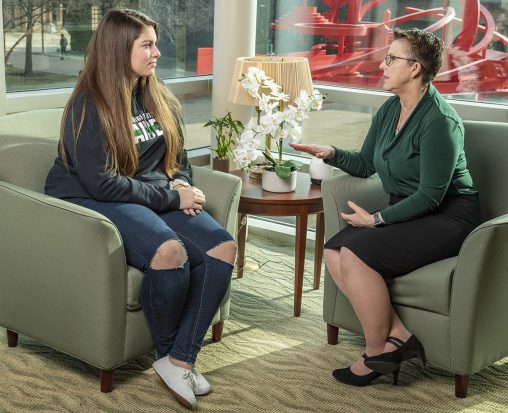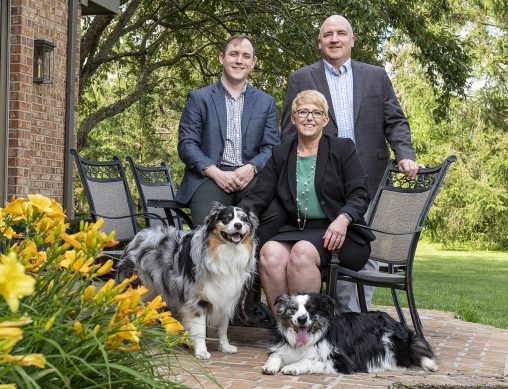
Wright State University President Sue Edwards wears a black bracelet on her right wrist in support of the Student Government Association’s “Because I Said I Would” initiative. This social movement encourages people to make promises and stand by them.
On a Saturday morning in late October 2019, Sue Edwards walked into a meeting of the Wright State University Board of Trustees, thinking she was only on hand in case the board had some questions.
As the meeting progressed, the board asked Edwards to become the university’s next president. It was a turn of events that Edwards could not have imagined, even in her wildest dreams.
An unexpected path
When former president Cheryl B. Schrader decided to retire, Edwards—who had been serving as executive vice president for academic affairs and provost since 2018—began having initial discussions with the Board of Trustees about how to move the university forward. Edwards viewed these only as strategic conversations and assumed she would just carry on in her role as provost.
“I never really thought about being president,” said Edwards. “It was truly not something that was even in my vision.”
To keep the train on the tracks, the board asked Edwards to do double duty by continuing her work as provost while overseeing the day-to-day operations of the university. Shortly thereafter, they appointed Edwards as Wright State’s eighth president, effective January 1, 2020.
“At that point, it doesn’t become about you. It becomes about what is the best for the institution,” said Edwards. “We had to turn the ship around. When you’re heading to the iceberg and you have the capacity to change the direction of the ship, you don’t bail. You do what is right for the ship.”
Edwards said she never envisioned becoming president of a university. In fact, she said she never thought she’d end up in the world of higher education.
Interested in law, Edwards began her career at a forensics lab in an Australian hospital. Since the lab handled all of the coroner’s cases, she thought the position would provide her with valuable insight into criminal law. When the hospital offered to pay for her education, she began taking classes at night—while working full time—to earn her associate degree in medical laboratory science.
During her time in the forensics lab, Edwards became fascinated with the human body and how it functioned. At Royal Melbourne Hospital, a colleague recommended Edwards for a research position at the University of Melbourne, where she worked with Colin Anderson, a renowned neuroscientist and comparative physiologist. While working there full time, she went on to earn her bachelor’s degree in biology from Deakin University in Victoria, Australia. After earning her undergraduate degree, Anderson then encouraged her to get a master’s degree in neuroscience from the University of Melbourne, and go on to earn her Ph.D. in comparative physiology from Deakin University.
“I have been very lucky to have great mentors. It was only because of Colin that I knew academia was a career. I wouldn’t have known it was a career unless I’d taken that position with him,” Edwards explained. “You never say ‘no’ to an opportunity, because you don’t know where that opportunity is going to take you.”
Becoming president of a public institution of higher education has definitely taken Edwards outside of her comfort zone. Like any president, she has become the public face of the university. For a self-professed introvert like Edwards, this can often be a challenge.
“Doing these sort of interviews is horrendous for me, because I have to talk about me,” Edwards explained. “I don’t enjoy being in the limelight. If I can deflect the attention away from me and have it be all about the university, that’s exactly where I want it to be.”
Completely unassuming, she prefers to be addressed by her first name rather than “President Edwards.” She signs all campus-wide communications simply as “Sue.” Her informal approach stems in large part from growing up in a working-class family in her native Australia.
“Just because you have a title doesn’t change who you are. You just have to be your authentic self,” she said. “My dad always told me, ‘You are no better than anyone else and no one else is any better than you.’ My family is still happy to bring me back down to earth if I ever get any illusions of grandeur.”
Edwards’ commitment to being a straight shooter has never been more apparent than during the COVID-19 pandemic. As the third month of Edwards’ presidency got underway, the university had to quickly shift gears and switch to remote learning for the remainder of the spring semester.
For a university that had just navigated financial recovery and avoided state fiscal watch after years of budget deficits and depleted reserves, the pandemic dealt an especially hard blow.
“We knew we still had some challenges ahead, and I think we had a really good plan for them,” she said, “and then we just had the rug ripped from underneath us.”
Throughout the closure of the Dayton and Lake Campuses, Edwards communicated twice weekly with Wright State students, faculty, and staff via live, online chats. She never pulled punches, and insisted on transparency about the potential economic fallout of the pandemic and the difficult days that could lie ahead.
“The hard thing for me is that we’re going to have to make decisions that impact people and impact the trajectories of students,” she said. “I hate that I’m adding stress to people’s lives. The hardest thing about this job is understanding that every decision you make impacts somebody.”
Despite the challenges of the COVID-19 pandemic, Edwards is ever the optimist. She subscribes to the mantra that “together is better,” and if the entire Wright State community unites, they can ensure the long-term sustainability of the university and continue to provide opportunities for students to thrive.
“At the end of the day,” said Edwards, “we’re in the business of people and helping them succeed in whatever avenue they want to pursue.”

When speaking with students about their classes and personal lives, President Edwards often asks what she can do to ensure their best possible student experience.
Getting back to basics with the three R’s
For Edwards, turning around an institution of more than 10,000 students and over 2,000 faculty and staff all ties back to three pressing priorities: recruitment, retention, and relationships.
“We have to rebuild. We have to get back to the core mission of the institution, which is providing an educated workforce for the region,” she said. “That’s why Wright State was created.”
After joining Wright State as provost, it became clear to Edwards that the university needed to do a better job of recruiting. She has continued to shift more dollars into marketing to recruit new students and boost enrollment.
Once students are at Wright State, it’s critical to Edwards that they receive the support and individualized attention they need to succeed and stay on track to graduation. That commitment to creating a culture that supports student success continues even when students are not on campus.
When the COVID-19 pandemic canceled all in-person classes, more than 200 faculty and staff volunteered to call students to see how they were transitioning to remote learning.
“That’s the level of care that we want to get to. It takes a village to do that,” said Edwards. “We don’t want our students to feel as though they’re a number. We want them to feel connected to us and that they’re valued as individuals. That is how we retain them and how they’re going to be successful.”
Providing opportunities for students to learn beyond the classroom is also essential to helping students feel engaged and ready for the workforce. Edwards is dedicated to developing and nurturing the university’s relationships with employers, organizations, and nonprofits throughout the region, so more students will be able to participate in internships and experiential learning.
A firm believer that Wright State is one of the region’s greatest assets, Edwards is eager to listen to community partners and ask them how the university can help them be successful.
“We have to be a little bit more innovative in our approaches,” said Edwards. “We have areas where we can maximize, such as our connection to Wright-Patterson Air Force Base and the health care industry. There is a lot of opportunity there for long-term connections.”
The path forward
Just as Edwards never envisioned becoming a university president, she also thought she wouldn’t end up at Wright State. When she was first contacted by a search firm about the provost position at Wright State, she was hesitant to apply. After all, she was perfectly happy in her roles as vice provost for faculty affairs and professor of biology at Appalachian State University in Boone, North Carolina.
After much consideration, Edwards ended up applying for the job but thought nothing would come of it. To her surprise, Edwards was invited to come to campus to interview. That was the moment everything changed.
On the first day of her visit, Edwards had lunch with four students in the Student Union’s Wright Brothers Room. She found common ground as she listened to the students describe the challenges of working full time while putting themselves through school, just as Edwards had done. And she was captivated by their dreams of wanting to make the world a better place.
“After that lunch,” she recalled, “I suddenly switched from ‘This is a nice experience’ to ‘I really want this job.’ What drew me to Wright State was the students I would be serving.”
Edwards’ said her commitment to Wright State’s students will be the cornerstone of her presidency and her driving force moving forward.
“The reason I do anything that I do is for the students,” she said. “It’s not about me. It’s about them. It’s about what makes them successful. That is the reason I am here at Wright State.”
Edwards is also well aware that the institutions of higher education that will survive—and even thrive—in the COVID-19 pandemic world are the ones that connect with students.
“It’s crunch time,” said Edwards. “We have to be thinking about how we are going to change as an industry.”

Sue Edwards, her son Marcus Funston, left, her husband Greg Funston, right, and their two Australian shepherds, Sting and Bowie, at home in Beavercreek.
In many ways, the pandemic has been a great leveler for all of higher education.
“This has definitely put higher education, at the national level, under stress,” said Edwards. “We’re all in the same boat. Every institution in the country is going through some form of hardship.”
Edwards said one saving grace for Wright State is that even though the university has fewer reserves than other institutions, it also has less debt. But as state support continues to dwindle, the financial future for all of Ohio’s colleges and universities remains uncertain.
Edwards said she takes comfort in knowing the entire Wright State family can come together to ensure the university’s sustainability and momentum.
“We have an opportunity to create an institution that will survive for the long haul,” said Edwards. “But we can’t make an impact without everybody. This has to be all or none. Everybody that’s part of the Wright State community has a role to play in this—whether it’s faculty, staff, alumni, or students. We all have a responsibility to take ownership of it.”
To inspire current and future students, Edwards encourages all alumni to share their Wright State stories.
“Come and reengage with the campus. Come and talk to our students,” she urged. “Our students need to see how successful you’ve been.”
With 80 percent of Wright State’s graduates remaining in the Dayton area, where they are part of the economic workforce of the region, Edwards would like to create a new tradition where alumni come back to campus and tell others about their Wright State experience.
“That is what keeps alumni engaged,” she said. “And that’s what keeps students coming in the door.”
Getting to know Sue
Favorite book: “Love in the Time of Cholera” by Gabriel García Márquez
Favorite movie: I’m a huge “Star Wars” fan. Anything “Star Wars” or Marvel.
Favorite meal: Anything my husband is cooking. I also love Thai food.
Favorite entertainer: Chris Hemsworth
Guilty pleasure: Mowing the lawn
Hobbies: Gardening, kayaking, hanging out with my family
Family life: Includes her husband, Greg Funston, and son, Marcus, and two Australian shepherds, Sting and Bowie
Other than your family and friends, what do you miss the most about your native Australia?
The laid-back nature of Australia. I am not very formal. I find America very formal. Sometimes that’s exhausting.
What was the biggest cultural shock when you moved to the United States?
The bureaucracy. Not that bureaucracy didn’t exist in Australia, but I guess I was used to it. [It got] reduced once we became American citizens. We’ve been American citizens now for three years.
What do you most want people to know about you?
I’ll always try to do the best thing for everybody. It may not necessarily be perceived that way, but what I do every day is work for other people.
What the heck is a hagfish?
One of Sue Edwards’ greatest passions is her research on a fish most people have never even heard of—the hagfish.
Edwards was first introduced to hagfish as a Ph.D. candidate in comparative physiology at Deakin University in Victoria, Australia. For the first year, she never saw a hagfish; she just worked with its DNA. In 1998, she spent the summer at Mount Desert Island biological lab in Maine, where she met her first hagfish.
“They’re just absolutely fascinating organisms,” said Edwards. “They’re like the vacuum cleaners of the sea.”
Found in most of the world’s major oceans, hagfish share characteristics with both insects and humans. While they do not have a jaw, they use their mouth—similar to that of a snail—to consume the flesh of organisms that have died and dropped to the bottom of the ocean. They can survive for long periods of time without eating.
Researchers know little about hagfish except the slime they produce has similar properties to Kevlar. It’s possible the protein structure in hagfish slime could be utilized for producing bullet-proof vests, clothing, and other materials.
Hagfish play a significant ecological role, but are currently in danger of being overfished. As oceans become warmer due to climate change, it’s unknown how this will impact hagfish.
“They are critical to keeping the ocean in balance,” said Edwards. “That’s why we need to learn more about them.”
This article was originally published in the fall 2020 issue of the Wright State Magazine. Find more stories at wright.edu/alumnimag.









 More than 1,000 students to graduate at Wright State’s fall commencement ceremonies
More than 1,000 students to graduate at Wright State’s fall commencement ceremonies  Wright State’s Take Flight Program helps students soar high
Wright State’s Take Flight Program helps students soar high  Wright State Police Department delivers major donation to Raider Food Pantry
Wright State Police Department delivers major donation to Raider Food Pantry  Wright State engineering and computer science students earn prestigious federal SMART Scholarships
Wright State engineering and computer science students earn prestigious federal SMART Scholarships  Wright State Police Chief Kurt Holden selected for prestigious FBI National Academy program
Wright State Police Chief Kurt Holden selected for prestigious FBI National Academy program 